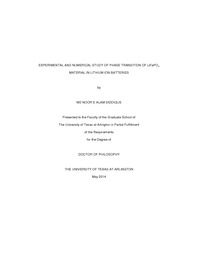
ATTENTION: The works hosted here are being migrated to a new repository that will consolidate resources, improve discoverability, and better show UTA's research impact on the global community. We will update authors as the migration progresses. Please see MavMatrix for more information.
Show simple item record
| dc.contributor.author | Siddique, Md Noor E Alam | en_US |
| dc.date.accessioned | 2014-07-14T20:26:58Z | |
| dc.date.available | 2014-07-14T20:26:58Z | |
| dc.date.issued | 2014-07-14 | |
| dc.date.submitted | January 2014 | en_US |
| dc.identifier.other | DISS-12686 | en_US |
| dc.identifier.uri | http://hdl.handle.net/10106/24438 | |
| dc.description.abstract | Phase transition behavior of LiFePO4 material has been studied in this work. During electrochemical charge/discharge processes, LiFePO4 transforms into FePO4 and this electrochemically driven phase transition of the two-phase system results in a potential plateau in a battery discharge curve. Besides, battery performance, especially under high rates, depends critically on this two-phase transition. However, this phase transition mechanism in the LiFePO4 crystal structure has yet not been understood in details. Developing better understanding is essential for designing high performing, safe and stable batteries.Currently available phase transition models for LiFePO4, such as the classical `core-shrinking model' and recently the `domino cascade model', have shed lights on the phase transition mechanism, however, with somewhat contradicting conclusions. The former predicted a continuous phase transition between LiFePO4 and FePO4 within an individual particle. In contrast, the latter, based on the fact of anisotropic diffusion of Li, provided a microscopically heterogeneous picture of phase transition: phase transition is abrupt, and de-lithiated and lithiated particles co-exist in a battery electrode. To achieve a better understanding of the two-phase transition phenomena, two specially designed sophisticated methods, i.e., in-situ Raman spectroscopy and in-situ X-ray Diffraction (XRD), have been developed in this work. The particle level phase transition of LiFePO4 was probed in the in-situ Raman study. Under slow-rate discharge/charge, it was found that the particles were either fully transformed or untransformed indicating that the phase transition in LiFePO4 material was not uniform at the particle level. Electronic conductivity and local electrode microstructure determined the preferred sequence of phase transition of the particles. This study also revealed that non-equilibrium phase transition occurred as a result of delayed phase transition. The in-situ XRD study attempted to investigate the bulk level phase transition behavior of LiFePO4 and was conducted at four different discharge rates. Analysis of the high-resolution diffraction patterns showed a gradual and continuous change in phase transition. Again, a delayed phase transition was observed at high-rate discharge due to the non-equilibrium pathway. From both in-situ Raman and in-situ XRD experiments, only two stoichiometric compounds (LiFePO4 and FePO4) was detected, indicating that during electrochemical charge/discharge processes once Li ion de-intercalates/intercalates, it immediately forms the end-members and no intermediate compounds exist.Particle size and morphology of LiFePO4 were also studied using numerical models in the phase transition behavior. At a slow discharge rate, plate shaped particles showed higher capacity than spherical particles and the opposite trend was observed at high discharge rates above some critical discharge rates. Big particles and high discharge rates induced non-equilibrium phase transition in the LiFePO4 particles which expands the miscibility gap between the end-members and gave sharp narrow two-phase interfaces. | en_US |
| dc.description.sponsorship | Liu, Fuqiang | en_US |
| dc.language.iso | en | en_US |
| dc.publisher | Materials Science & Engineering | en_US |
| dc.title | Experimental And Numerical Study Of Phase Transition Of LiFePO₄ Material In Lithium Ion Batteries | en_US |
| dc.type | Ph.D. | en_US |
| dc.contributor.committeeChair | Liu, Fuqiang | en_US |
| dc.degree.department | Materials Science & Engineering | en_US |
| dc.degree.discipline | Materials Science & Engineering | en_US |
| dc.degree.grantor | University of Texas at Arlington | en_US |
| dc.degree.level | doctoral | en_US |
| dc.degree.name | Ph.D. | en_US |
Files in this item
- Name:
- Siddique_uta_2502D_12686.pdf
- Size:
- 2.202Mb
- Format:
- PDF
This item appears in the following Collection(s)
Show simple item record


